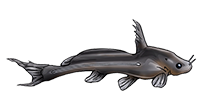Article © Shane Linder, uploaded January 01, 2002.
I start my diary entries Saturday 2nd September 2000. Initially the thought was that I would simply relay some of my collecting notes from this weekend. I also plan to later write up descriptions of the terrain since understanding the terrain is necessary to understanding the aquatic habitats.
From Caracas we traveled south down the Cordillera de la Costa towards the Northern Llanos. Basically, this journey brings you down from the mountains to the large flat plains known as the Llanos. Several rivers drain south down these slopes into the mighty Orinoco. I drove as far south as El Sombrero in the Northern Llanos. Unfortunately, since it is still the wet season, I found collecting here impossible. These flooded plains are just saturated mud at this time of year and it is impossible to get near any water without sinking dangerously deep in the mud. I attempted collecting in one roadside creek and quickly found myself knee deep in the mud and stuck. The mud was so thick that it literally sucked one of my sandals off of my foot. This made me mad as these were my collecting sandals which I have always used, collecting from the States to Ecuador. At this point I decided to leave the Llanos until the dry season and headed north back into the mountains.
The next collecting location was the Rio Pao just outside of San Sabastian. The Rio had a small amount of current and was muddy brown with sediment (as are most rivers in the wet season). The water temp was near 80°F and the Rio was about 15-20 feet wide. The typical depth was 6-12 inches with deep areas near cutbanks. By running a four foot by four foot seine along the shallows I was able to collect wild guppies and a number of cichlids. I seined the outside cutbanks where there were many overhanging land plants and managed to collect a fair number of Farlowella. The water was about two feet deep on the outside banks. Also collected was a small (2 inch) Hypostomus sp. This fish was collected from the center of the creek in the strongest rapids by basically pure luck. It got caught in my net as I was crossing the river. I continued up the mountains towards Caracas and stopped to sample the Rio Zuata in the village of San Casimiro. The collecting site was beautiful. A crystal clear mountain stream with a bed of fist-sized rocks. By seining near the banks I turned up pike cichlids, Hoplias, and a small species of tetra. In the main rapids I was able to collect a Chaetostoma sp. by kick seining. Although this was the most beautiful place to collect, it was also difficult. In the clear water the fishes could see me from far away and scatter. I saw many loricariids (sp. unknown) scramble away from me. I plan to try this site again with a 12 seine which should work much better.
Back to Shane's World index.




